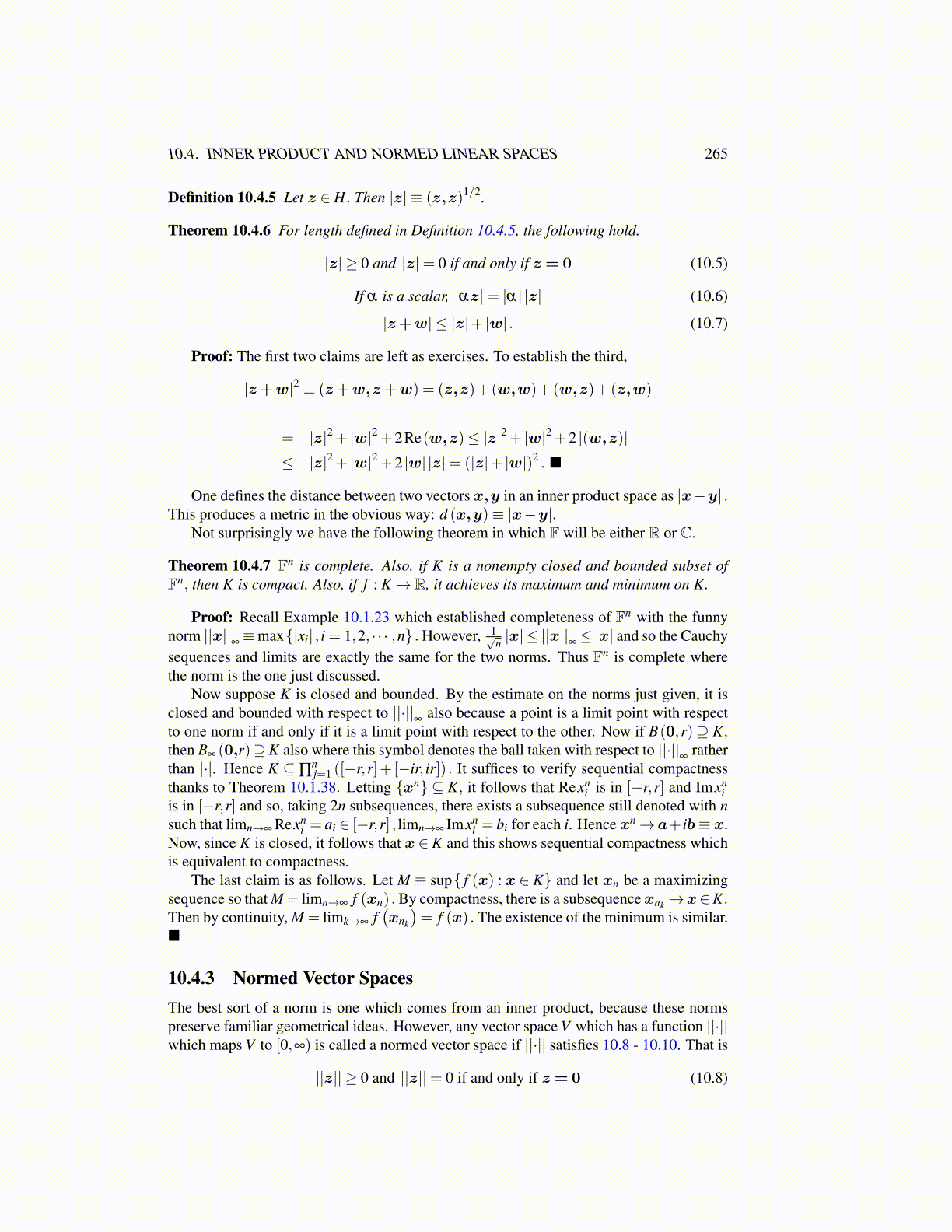
10.4. INNER PRODUCT AND NORMED LINEAR SPACES 265
Definition 10.4.5 Let z ∈ H. Then |z| ≡ (z,z)1/2.
Theorem 10.4.6 For length defined in Definition 10.4.5, the following hold.
|z| ≥ 0 and |z|= 0 if and only if z = 0 (10.5)
If α is a scalar, |αz|= |α| |z| (10.6)
|z+w| ≤ |z|+ |w| . (10.7)
Proof: The first two claims are left as exercises. To establish the third,
|z+w|2 ≡ (z+w,z+w) = (z,z)+(w,w)+(w,z)+(z,w)
= |z|2 + |w|2 +2Re(w,z)≤ |z|2 + |w|2 +2 |(w,z)|≤ |z|2 + |w|2 +2 |w| |z|= (|z|+ |w|)2 . ■
One defines the distance between two vectors x,y in an inner product space as |x−y| .This produces a metric in the obvious way: d (x,y)≡ |x−y|.
Not surprisingly we have the following theorem in which F will be either R or C.
Theorem 10.4.7 Fn is complete. Also, if K is a nonempty closed and bounded subset ofFn, then K is compact. Also, if f : K→ R, it achieves its maximum and minimum on K.
Proof: Recall Example 10.1.23 which established completeness of Fn with the funnynorm ||x||
∞≡max{|xi| , i = 1,2, · · · ,n} . However, 1√
n |x| ≤ ||x||∞≤ |x| and so the Cauchysequences and limits are exactly the same for the two norms. Thus Fn is complete wherethe norm is the one just discussed.
Now suppose K is closed and bounded. By the estimate on the norms just given, it isclosed and bounded with respect to ||·||
∞also because a point is a limit point with respect
to one norm if and only if it is a limit point with respect to the other. Now if B(0,r)⊇ K,then B∞ (0,r)⊇K also where this symbol denotes the ball taken with respect to ||·||
∞rather
than |·|. Hence K ⊆ ∏nj=1 ([−r,r]+ [−ir, ir]) . It suffices to verify sequential compactness
thanks to Theorem 10.1.38. Letting {xn} ⊆ K, it follows that Rexni is in [−r,r] and Imxn
iis in [−r,r] and so, taking 2n subsequences, there exists a subsequence still denoted with nsuch that limn→∞ Rexn
i = ai ∈ [−r,r] , limn→∞ Imxni = bi for each i. Hence xn→a+ ib≡ x.
Now, since K is closed, it follows that x ∈ K and this shows sequential compactness whichis equivalent to compactness.
The last claim is as follows. Let M ≡ sup{ f (x) : x ∈ K} and let xn be a maximizingsequence so that M = limn→∞ f (xn) . By compactness, there is a subsequence xnk→x∈K.Then by continuity, M = limk→∞ f
(xnk
)= f (x) . The existence of the minimum is similar.
■
10.4.3 Normed Vector SpacesThe best sort of a norm is one which comes from an inner product, because these normspreserve familiar geometrical ideas. However, any vector space V which has a function ||·||which maps V to [0,∞) is called a normed vector space if ||·|| satisfies 10.8 - 10.10. That is
||z|| ≥ 0 and ||z||= 0 if and only if z = 0 (10.8)